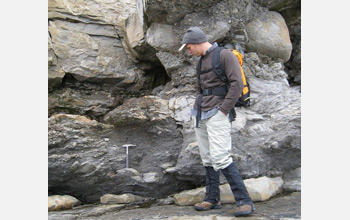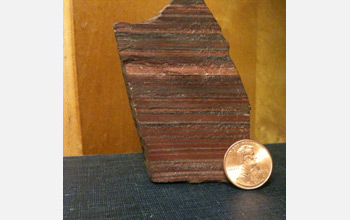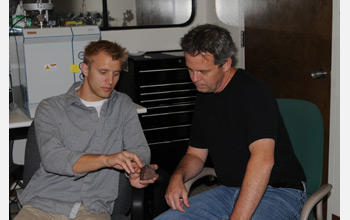All Images
News Release 10-202
New Evidence Supports Snowball Earth as Trigger for Early Animal Evolution
Spike in ancient marine phosphorus concentrations linked to emergence of complex life
This material is available primarily for archival purposes. Telephone numbers or other contact information may be out of date; please see current contact information at media contacts.

Geologist Noah Plavansky examines rocks deposited after a "Snowball Earth" glacial event.
Credit: Lyons Lab, UC-Riverside
Download the high-resolution JPG version of the image. (268 KB)
Use your mouse to right-click (Mac users may need to Ctrl-click) the link above and choose the option that will save the file or target to your computer.

Drill core of sediments with iron formations used to track marine phosphorus concentrations.
Credit: Lyons Lab, UC-Riverside
Download the high-resolution JPG version of the image. (595 KB)
Use your mouse to right-click (Mac users may need to Ctrl-click) the link above and choose the option that will save the file or target to your computer.

Close-up of a sample of 2.7 billion-year-old iron formation from Zimbabwe; red is hematite.
Credit: Lyons Lab, UC-Riverside
Download the high-resolution JPG version of the image. (139 KB)
Use your mouse to right-click (Mac users may need to Ctrl-click) the link above and choose the option that will save the file or target to your computer.

Scientists Noah Plavansky and Tim Lyons discuss attributes of a banded iron formation sample.
Credit: Lyons Lab, UC-Riverside
Download the high-resolution JPG version of the image. (5.4 MB)
Use your mouse to right-click (Mac users may need to Ctrl-click) the link above and choose the option that will save the file or target to your computer.


